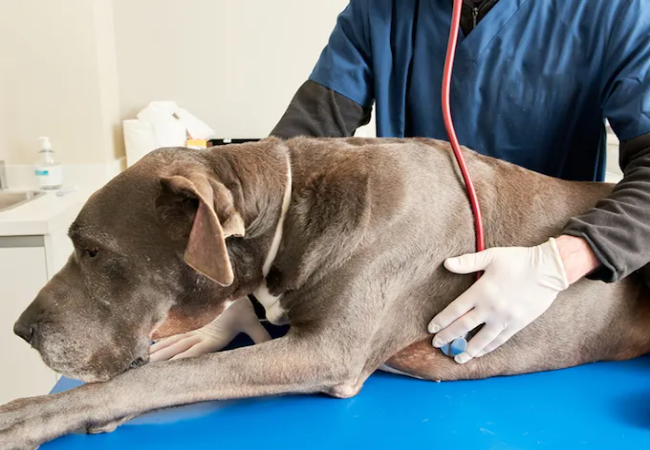Atrioventricular (Second-Degree Mobitz II) Heart Block in Dogs: 2025 Vet Guide 🩺🐾

In this article
Atrioventricular (Mobitz II) Heart Block in Dogs: 2025 Vet Guide 🩺🐶
By Dr. Duncan Houston BVSc
Hi! I’m Dr Duncan Houston, BVSc, veterinarian and founder of Ask A Vet. In this comprehensive 2025 guide, we explore a serious cardiac arrhythmia—second‑degree AV block, Mobitz type II—covering signs, causes, diagnosis, pacing therapy, and how telehealth improves outcomes.
1. 🫀 What is Mobitz Type II AV Block?
Mobitz type II is a severe form of second-degree AV block in which some P waves aren’t followed by QRS complexes, yet those that are conducted have a fixed PR interval. It stems from disease in the His‑Purkinje system—often below the AV node.
2. ⚠️ Why It’s Serious
- High risk of progressing to third-degree (complete) AV block, which can cause syncope or sudden death.
- Stable PR intervals suggest fixed conduction disease, unlike Mobitz type I.
- Often associated with wide QRS complexes and bradycardia, indicating structural conduction system problems.
3. 🧬 Causes & Risk Factors
- Degenerative fibrosis of the His‑Purkinje system, especially in older dogs.
- Cardiac disease (myocarditis, cardiomyopathy), neoplasia, Lyme disease.
- Electrolyte imbalances (e.g., hypokalemia), drug effects (digoxin, beta-blockers).
- Common in breeds like Pugs, Cocker Spaniels, Dachshunds, and Dobermans.
4. 🐶 Clinical Signs
- Often asymptomatic, but may include weakness, collapse, syncope.
- Signs of cardiac inefficiency—poor exercise tolerance, lethargy, occasional coughing.
- Bradycardia, intermittent pauses visible on ECG.
5. 🧪 Diagnostic Steps in 2025
- History & physical: Identify syncope, drug history, and breed predisposition.
- Resting ECG: Confirms Mobitz type II—fixed PR with non-conducted P waves.
- Holter monitoring: Detects frequency of conduction failures.
- Echo & X-ray: Evaluate structural heart disease.
- Bloodwork: Check electrolytes, digoxin levels, and infection markers.
- Atropine response test: Distinguishes vagal-induced blocks vs structural.
6. 🛠 Treatment Overview
6.1 Emergency Stabilization
- If bradycardia causes syncope or hypotension, transcutaneous or transvenous pacing may be needed quickly.
- Atropine or theophylline/terbutaline can offer temporary support.
6.2 Permanent Pacemaker
Pacemaker implantation is considered the definitive therapy, essential to prevent progression and sudden death.
- Dogs with symptomatic Mobitz II or high-grade block usually need pacemakers.
- Leads and device selection depend on anatomical and technical factors.
- Post-implant care includes yearly checks, ECG/X-rays, and monitoring of device integrity.
6.3 Manage Underlying Conditions
- Treat electrolyte imbalances, infections, toxicities, cardiac disease, etc.
- Discontinue AV nodal-suppressive medications like digoxin where appropriate.
7. 📈 Prognosis & Monitoring
- Without a pacemaker, the risk of progression to complete AV block and sudden death is high.
- With a pacemaker, many dogs live 2–5+ years, enjoying a good quality of life.
- Regular follow‑ups—pacemaker function, device battery, structure, ECG, and enzyme levels.
8. 🏡 Home & Telehealth Care
- Monitor heart rate, breathing, behavior, and exercise tolerance.
- Ensure timely pacemaker check-ups and ECGs.
- Use the Ask A Vet app to upload ECGs, receive medication reminders, and connect with cardiologists.
- Get alerts for syncope or breathing changes through teleface consultations.
9. 🔬 2025 Advances
- Wearable ECG patches stream continuous data to cloud apps.
- AI rhythm analyses detect block progression early.
- Remote device telemetry allows off-site pacemaker checks.
- Mini leadless pacemakers reduce implant complications.
- Telemedicine consultations tie together local and specialist cardiac care.
10. 💬 Owner FAQs
- Will a pacemaker surgery hurt?
- The procedure is safe in expert hands with low complication risk.
- Can we wait on pacemakers?
- If your dog is syncope-free with preserved rate, short-term monitoring may be OK—but pacemaker is usually advised.
- Will meds help?
- Temporary drugs may help, but pacemaker is usually the only long-term solution.
- Is this genetic?
- Genetic predisposition is suspected in breeds like Pugs or Cocker Spaniels but evidence is limited.
11. ❤️ Ask A Vet Telehealth Integration
- Upload ECGs & Holter tracings for interpretation.
- Receive alerts for missed beats and syncope.
- Get medication/treatment reminder support post-pacemaker.
- Connect with cardiologists to coordinate pacemaker care with local vets.
12. 🔚 Final Thoughts
Mobitz type II AV block is a potentially life-threatening arrhythmia that risks sudden heart block without intervention. In 2025, early detection, prompt pacing intervention, AI-supported monitoring, and telehealth will ensure dogs can live full lives after diagnosis. Collaborate with your vet and Ask A Vet to give your pup the best chance at stable, healthy years ahead.
— Dr Duncan Houston, BVSc






